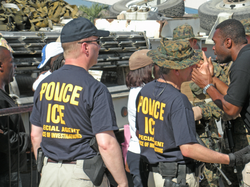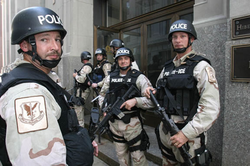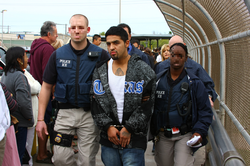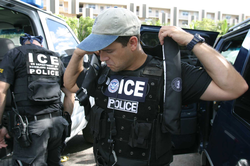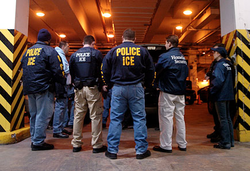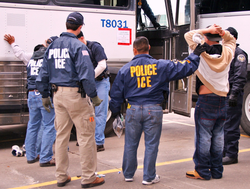U.S. Immigration and Customs Enforcement
U.S. Immigration and Customs Enforcement
| U.S. Immigration and Customs Enforcement | |
|---|---|
| Abbreviation | ICE |
| Motto | "Protecting National Security and Upholding Public Safety" |
| Agency overview | |
| Formed | March 1, 2003; 14 years ago(2003-03-01) |
| Preceding agencies |
|
| Employees | 20,000+ (2016) |
| Annual budget | $5.34 billion (2014) |
| Legal personality | Governmental:Government agency |
| Jurisdictional structure | |
| Federal agency | United States |
| Constituting instrument | Homeland Security Act of 2002 |
| General nature |
|
| Operational structure | |
| Headquarters | Washington, D.C. |
| Agency executives |
|
| Parent agency | U.S. Department of Homeland Security |
| Website | |
| ice.gov | |
U.S. Immigration and Customs Enforcement (or ICE) is a U.S. federal government law enforcement agency under the jurisdiction of the Department of Homeland Security (DHS). ICE has two primary components: Homeland Security Investigations (HSI) and Enforcement and Removal Operations (ERO). Headquartered in Washington, D.C., ICE is charged with the investigation and enforcement of over 400 federal statutes within the United States, and maintains attachés at major U.S. embassies overseas.
ICE is led by a director who is appointed at the sub-Cabinet level by the President, confirmed by the Senate, and reports directly to the Secretary of Homeland Security. [undefined] [undefined] Until July 2010 the title had been Assistant Secretary. [undefined] ICE is the second-largest criminal investigative agency in the U.S. government after the FBI. [undefined]
| U.S. Immigration and Customs Enforcement | |
|---|---|
| Abbreviation | ICE |
| Motto | "Protecting National Security and Upholding Public Safety" |
| Agency overview | |
| Formed | March 1, 2003; 14 years ago(2003-03-01) |
| Preceding agencies |
|
| Employees | 20,000+ (2016) |
| Annual budget | $5.34 billion (2014) |
| Legal personality | Governmental:Government agency |
| Jurisdictional structure | |
| Federal agency | United States |
| Constituting instrument | Homeland Security Act of 2002 |
| General nature |
|
| Operational structure | |
| Headquarters | Washington, D.C. |
| Agency executives |
|
| Parent agency | U.S. Department of Homeland Security |
| Website | |
| ice.gov | |
History
U.S. Immigration and Customs Enforcement was formed pursuant to the Homeland Security Act of 2002, following the events of September 11, 2001. With the establishment of the Department of Homeland Security, the functions and jurisdictions of several border and revenue enforcement agencies were combined and consolidated into U.S. Immigration and Customs Enforcement. Consequently, ICE is the largest investigative arm of the Department of Homeland Security, and the second largest contributor to the nation's Joint Terrorism Task Force.
The agencies that were either moved entirely or merged in part into ICE included the investigative and intelligence resources of the United States Customs Service, the criminal investigative, detention and deportation resources of the Immigration and Naturalization Service, and the Federal Protective Service. The Federal Protective Service was later transferred from ICE to the National Protection and Programs Directorate effective October 28, 2009. In 2003, Asa Hutchinson moved the Federal Air Marshals Service from the Transportation Security Administration to ICE, [undefined] but Chertoff moved them back to the TSA in 2005. [46]
Organization
U.S. Immigration and Customs Enforcement is responsible for identifying and eliminating border, economic, transportation, and infrastructure security vulnerabilities.
There is an estimate of about more than 20,000 ICE employees in approximately over 400 offices within the United States including 46 other countries.
The organization is composed of two law enforcement directorates and several support divisions each headed by a director who reports to an Executive Associate Director.
[undefined] The divisions of ICE provide investigation, interdiction and security services to the public and other law enforcement partners in the federal and local sectors.
Structure
Director Deputy Director Enforcement and Removal Operations Removal Division Secure Communities and Enforcement Division Immigration Health Services Division Mission Support Division Detention Management Division Local Field Offices Homeland Security Investigations Domestic Operations Division Intelligence Division International Operations Division Mission Support National Intellectual Property Rights Coordination Center National Security Investigations Division Management and Administration
Homeland Security Investigations (HSI)
HSI special agents investigate a range of issues that threaten the national security of the United States such as human rights violations, human smuggling, art theft, human trafficking, drug trafficking, arms trafficking, document-benefit fraud, the manufacturing and sale of counterfeit immigration and identity documents, transnational gangs, financial crimes including money laundering and bulk cash smuggling, trade-based money laundering (including trade finance and Kimberley Process investigations), computer crimes, including the production and transportation of child pornography via the Internet, import/export enforcement, trafficking of counterfeit pharmaceuticals and other merchandise, and international Cultural Property and Antiquities crimes. HSI agents can be requested to provide security for VIPs, and also augment the U.S. Secret Service during overtaxed times such as special security events and elections.
HSI was formerly known as the ICE Office of Investigations (OI).
HSI agents have the statutory authority to enforce the Immigration and Nationality Act (Title 8), U.S. customs laws (Title 19), general federal crimes (Title 18), the Controlled Substances Act (Title 21), as well as Titles 5, 6, 12, 22, 26, 28, 31, 46, 49, and 50 of the U.S. Code. HSI has more than 6,500 special agents, making it the largest investigative entity in the Department of Homeland Security and the second largest in the federal government.
Intelligence
The Office of Intelligence is a subcomponent of HSI that employs a variety of special agents and Intelligence Research Specialists to facilitate HSI's tactical and strategic intelligence demands.
Collectively, these intelligence professionals collect, analyze, and disseminate intelligence for use by the operational elements of DHS. The Office of Intelligence works closely with the intelligence components of other federal, state, and local agencies. Many HSI field offices assign intelligence analysts to specific groups, such as financial crimes, counter-proliferation, narcotics, or document fraud; or, alternatively, they can be assigned to a residential intelligence unit, known as a Field Intelligence Group (FIG). HSI agents assigned to FIGs generally focus on Human Intelligence (HUMINT) collection.
International Operations
_training_using_armored_vehicle.jpg)
HSI Special Response Team (SRT) members training using armored vehicle at Fort Benning in Georgia.
International Operations, formerly known as the Office of International Affairs (OIA), is a subcomponent of HSI with agents stationed in 60 locations around the world.
HSI's foreign offices, known as Attaché Offices, work with foreign governments to identify and combat transnational criminal organizations before they threaten the United States.
IO also facilitates domestic HSI investigations by providing intelligence from host countries, conducting collateral investigations, and facilitating international investigations conducted by field offices within the United States.
Special Response Teams
Seventeen HSI field offices maintain a Special Response Team (SRT) that operates as a federal SWAT element for the office's area of responsibility (AOR). [undefined] SRT was founded under the U.S. Customs Service as the Warrant Entry and Tactical Team (WETT) and were renamed to SRT in 1998. [undefined] The SRT handle HSI's high-risk arrest and search warrants, barricaded subjects, rural area operations, VIP protection, sniper coverage for high-risk operations, and security for National Security Events. HSI's active SRTs are located in Tampa, Miami, Arizona (Phoenix), New Orleans, Houston, New York, Boston, Dallas, Los Angeles, St. Paul, San Juan, Detroit, San Francisco, El Paso, Chicago, San Diego and Washington, D.C. There is also a team of instructors and coordinators stationed full-time in Columbus, Georgia. These teams primarily deploy to handle high-risk operations, but also assist in events such as Hurricane Katrina, the Haiti earthquake 2010, and other natural disasters around the globe.
SRT is a collateral duty open to HSI agents assigned to an office with a certified team.
To qualify, candidates must pass a physical fitness test, qualify with multiple firearms by shooting 90% or better in full tactical gear, and pass an oral interview process.
If a candidate passes these stages and is voted on the local team, they are then designated "Green Team" members and allowed to train with the certified team members.
Green Team members are eventually sent to the SRT certification school at Fort Benning, Georgia, where they must pass additional physical fitness, firearms, scenario-based and written assessments. [undefined] Out of approximately 6,500 special agents, there are currently only approximately 250 certified SRT members nationwide.
HSI SRTs often conduct training exercises with various federal, state and local teams, and also assist other teams during national events or large-scale operations that require multiple high-risk scenarios to be conducted simultaneously.
The working relationship between the SRTs and the U.S. Department of Defense's U.S. Special Operations Command has led to SOCOM providing the SRTs with excess Mine Resistant Ambush Protected Vehicles (MRAPs), firearms, and other gear designed for the U.S. Tier One groups.
Enforcement and Removal Operations (ERO)
ERO is responsible for enforcing the nation's immigration laws and ensuring the departure of removable aliens from the United States.
ERO uses its deportation officers to identify, arrest, and remove aliens who violate U.S. immigration law.
Deportation officers are responsible for the transportation and detention of aliens in ICE custody to include the removal aliens to their country of origin.
Deportation officers prosecute aliens for violations of U.S. immigration and criminal law, monitor cases during deportation proceedings, supervise released aliens, and remove aliens from the United States.
[undefined] Deportation officers operate strategically placed Fugitive Operations Teams whose function is to locate, apprehend, and remove aliens who have absconded from immigration proceedings and remain in the United States with outstanding warrants for deportation.
ERO manages the Secure Communities program which identifies removable aliens located in jails and prisons. Fingerprints submitted as part of the normal criminal arrest and booking process will automatically check both the Integrated Automatic Fingerprint Identification System (IAFIS) of the FBI’s Criminal Justice Information Services (CJIS) Division and the Automated Biometric Identification System (IDENT) of the Department of Homeland Security’s US-VISIT Program.
ERO was formerly known as the Office of Detention and Removal Operations (DRO).
Office of State, Local and Tribal Coordination (OSLTC)
OSLTC is ICE's primary outreach and communications component for state, local and tribal stakeholders.
It is responsible for building and improving relationships, and coordinating activities with state, local, territorial, and tribal law enforcement agencies and through public engagement.
It also fosters and sustains relationships with federal, state and local government officials and coordinates ICE ACCESS programs (Agreements of Cooperation in Communities to Enhance Safety and Security).
Office of the Principal Legal Advisor (OPLA)
OPLA provides legal advice, training and services to support the ICE mission and defends the interests of the United States in the administrative and federal courts, including prosecution of foreign nationals for the purpose of removal (previously known as "deportation").
Office of Professional Responsibility
OPR is responsible for investigating allegations of misconduct involving employees of ICE.
OPR preserves the organizational integrity of U.S.
Immigration and Customs Enforcement by impartially, independently and thoroughly investigating allegations of criminal or serious administrative misconduct by ICE employees worldwide.
Additionally, OPR inspects and reviews ICE offices, operations and processes so as to provide executive management with independent reviews of the agency's organizational health.
In this role, OPR assesses the effectiveness and efficiency of ICE in carrying out its mission.
Former units
The Federal Air Marshal Service (FAMS) was aligned into ICE shortly after the creation of the Department of Homeland Security. On October 16, 2005, Homeland Security Secretary Michael Chertoff officially approved the transfer of the Federal Air Marshal Service from the Bureau of Immigration & Customs Enforcement (ICE) to the Transportation Security Administration (TSA) as part of a broader departmental reorganization to align functions consistent with the Department of Homeland Security (DHS) "Second Stage Review" findings for:
consolidating and strengthening aviation law enforcement and security at the Federal level;
creating a common approach to stakeholder outreach; and
improving the coordination and efficiency of aviation security operations.
As part of this realignment, the Director of the Federal Air Marshal Service also became the Assistant Administrator for the TSA Office of Law Enforcement (OLE), which houses nearly all TSA law enforcement services.
The Federal Protective Service (FPS) was moved from the General Services Administration (GSA) to ICE upon the creation of the Department of Homeland Security (DHS). The FPS was later moved out of ICE to the National Protection Programs Directorate.
Originally a part of the U.S Customs Service's Office of Investigations, the Office of Air and Marine (then called the Air and Marine Interdiction Division) was transferred to ICE in 2003 during the creation of the Department of Homeland Security, becoming the Office of Air and Marine Operations. Due in part to a 500 million dollar budgetary dispute between CBP and ICE, in 2004 ICE Air and Marine Operations was transferred to U.S. Customs and Border Protection. CBP Air and Marine still works closely with ICE to support the agency's domestic and international law enforcement operations. [undefined] [undefined] [undefined] [undefined]
The Office of Detention Policy and Planning was responsible developing and maintaining ICE's National Detention Standards, which set out detailed rules for how immigration detainees were to be treated differently than criminal inmates.
[undefined] In April 2017, President Donald Trump decided to close the office and to stop including the standards in new jail contracts. [undefined]
Assistant Secretaries and Directors
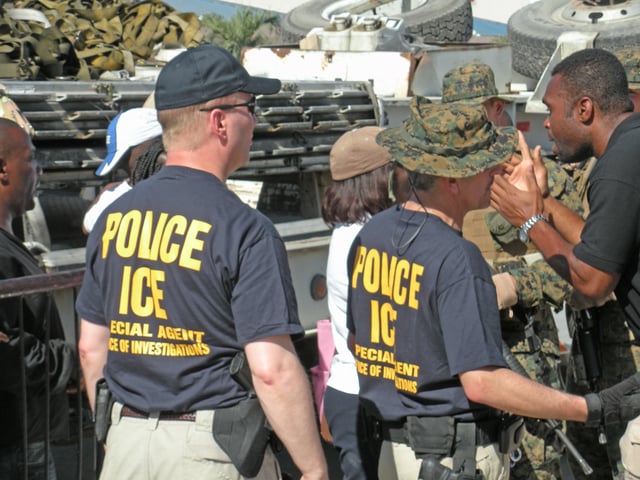
HSI special agents aiding with rescue effort for the 2010 Haiti earthquake
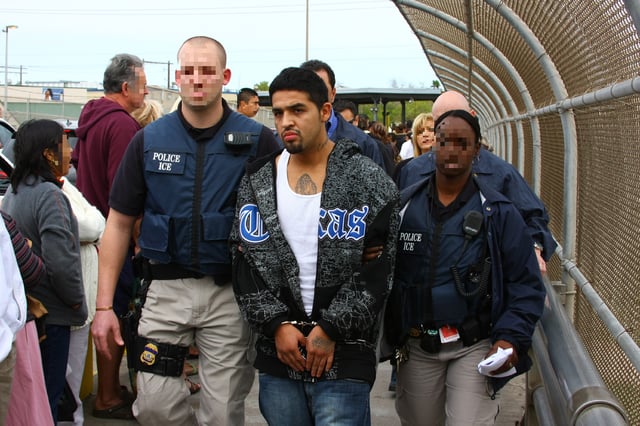
ICE ERO officers deporting a man wanted for two murders in Mexico.
No. | Picture | Name | Took office | Left office | Notes | President |
|---|---|---|---|---|---|---|
Assistant Secretary | ||||||
1 | ||||||
Training
Newly hired ICE law enforcement personnel receive their training at the Federal Law Enforcement Training Center in Glynco, Georgia. To meet division specific academic and practical instruction, the ICE Academy varies in length from 4 to 6 months depending on the position. Furthermore, following graduation, all ICE law enforcement personnel undergo additional post academy training, as well as career-continuous training. Specific course curriculum is kept confidential, but both ERO and HSI new hires undergo training related to basic law enforcement tactics, immigration law, firearms training, emergency response driving, and Constitutional law. HSI agents also receive training regarding U.S. customs law, warrant service, advanced tactics, undercover operations, criminal interrogation, weapons of mass destruction, and other subjects routinely encountered by HSI agents in the field. ERO deportation officers undergo several weeks of intensive Spanish language training prior to graduating.
Equipment
HSI special agents and ERO deportation officers are issued the SIG Sauer P229R pistol, with an agency-modified DAK (Double Action Kellerman) trigger, chambered in the .40 S&W cartridge, as their primary sidearm. Secondary weapons are on a list of authorized weapons published by the agency to its agents and officers. They also may be assigned the Remington Model 870 shotgun or the Colt M4 carbine. Agents can also be assigned the Heckler & Koch MP5 submachine gun.
ICE operates the only nationwide radio communication system in the federal law enforcement community.
The system, known as the National Law Enforcement Communications Center (NLECC) is Motorola-based and employs a technology specifically designed for ICE known as COTHEN (Customs Over The Horizon Network).
Consequently, HSI special agents, ICE officers, and authorized subscribers are able to communicate with one another across the nation using NLECC's strategically placed repeaters and high-speed data lines.
The center, commonly referred to internally as Charlie-100, is based in Orlando, Florida.
Investigative programs
National security
The National Security Division monitors the conduct of field enforcement operations in the investigation, detection, interdiction, prosecution, and removal of foreign-born terrorists, terrorist supporters, and hostile foreign intelligence agents located within the United States.
This branch also has operational oversight of all HSI special agents assigned to the 103 Joint Terrorism Task Forces (JTTF), provides continuous support to all counter-terrorism investigations and HSI field offices supporting those counter-terrorism efforts and provides actionable proactive counter-terrorism lead information, in furtherance of preventing and disrupting alien terrorist cells domestically and abroad. [undefined]
Transnational gangs
In February 2005, ICE began Operation Community Shield, a national law enforcement initiative that targets violent transnational street gangs through the use of ICE's broad law enforcement powers, including the unique and powerful authority to remove criminal aliens, including illegal aliens and legal permanent residents.
[undefined] Under Operation Community Shield, ICE:
Partners with federal, state and local law enforcement agencies, in the United States and abroad, to develop a comprehensive and integrated approach in conducting criminal investigations and other law enforcement operations against violent street gangs and others who pose a threat to public safety.
Identifies violent street gangs and develops intelligence on their membership, associates, criminal activities and international movements.
Deters, disrupts and dismantles gang operations by tracing and seizing cash, weapons and other assets derived from criminal activities.
Seeks prosecution and/or removal of alien gang members from the United States.
Works closely with our attaché offices throughout Latin America and foreign law enforcement counterparts in gathering intelligence, sharing information and conducting coordinated enforcement operations.
Conducts outreach efforts to increase public awareness about the fight against violent street gangs.
Drug trafficking
HSI agents share concurrent jurisdiction with the FBI and DEA in the enforcement of the Controlled Substances Act. HSI agents investigate drug trafficking organizations who import their products across the U.S. air, land and water borders, as well as their smuggling methods, which include the use of high-speed vessels, cargo containers, aircraft, commercial trucking, commercial vessel and human carriers. HSI agents enforce a wide range of federal drug statutes, and unlike DEA and FBI, can also use Title 19 of the U.S. Code to prosecute drug smugglers for the importation of drugs.
HSI drug trafficking investigations are often worked under the auspices of HSI-led Border Enforcement Security Taskforces (BEST), High Intensity Drug Trafficking Area (HIDTA) groups, and the Organized Crime Drug Enforcement Task Force. Through Memorandum of Understanding agreements, HSI's primary focus is the importation and subsequent trafficking of illegal drugs, while domestic production and sale is the focus of the DEA.
Cyber crimes
The Cyber Crimes Center (C3) Child Exploitation Section (CES) investigates the trans-border dimension of large-scale producers and distributors of images of child abuse, as well as individuals who travel in foreign commerce for the purpose of engaging in sex with minors. The CES employs the latest technology to collect evidence and track the activities of individuals and organized groups who sexually exploit children through the use of websites, chat rooms, newsgroups, and peer-to-peer trading. These investigative activities are organized under Operation Predator, a program managed by the CES. The CES also conducts clandestine operations throughout the world to identify and apprehend violators. The CES assists the field offices and routinely coordinates major investigations. The CES works closely with law enforcement agencies from around the world because the exploitation of children is a matter of global importance. [undefined]
C3 brings the full range of ICE computer and forensic assets together in a single location to combat such Internet-related crimes as:
Possession, manufacture and distribution of images of child abuse.
International money laundering and illegal cyber-banking.
Illegal arms trafficking and illegal export of strategic/controlled commodities.
Drug trafficking (including prohibited pharmaceuticals).
General Smuggling (including the trafficking in stolen art and antiquities; violations of the Endangered Species Act etc.)
Intellectual property rights violations (including music and software).
Immigration violations; identity and benefit fraud
C3 consists of four sections, three of which provide cyber technical and investigative services, the Cyber Crimes Section (CCS), the Child Exploitation Section (CES), and the Digital Forensic Section (DFS).
The fourth section, the Information Technology and Administrative Section (ITAS), provides the technical and *operational infrastructure services necessary to support the other three C3 sections.
The center is a co-location of special agents, intelligence research specialists, administrative support, and contractors, all of which are instrumental in operational and technical continuity.
Within each section, there are various program managers assigned to certain programmatic areas.
These program managers are responsible for supporting ICE Internet investigations through the generation and the dissemination of viable leads.
Program managers are available to provide guidance and training to field agents as well as to other law enforcement (foreign and domestic) upon request.
[undefined] Strategically located HSI Field Offices have their own Cyber Forensics Laboratories staffed by Computer Forensics Agents (CFAs).
These CFA's are HSI special agents who have been extensively trained in cyber investigative techniques and protocols.
The CCS is responsible for developing and coordinating investigations where the Internet is used to facilitate the criminal act.
These investigations include fraud, theft of intellectual property rights, money laundering, identity and benefit fraud, the sale and distribution of narcotics and other controlled substances, illegal arms trafficking and the illegal export of strategic/controlled commodities and the smuggling and sale of other prohibited items such as art and cultural property.
The CCS is involved in the development of Internet undercover law enforcement investigative methodology, and new laws and regulations to strengthen U.S.
Cyber-Border Security.
C3 supports the ICE Office of Investigation’s (OI) domestic field offices, along with ICE foreign attachés offices with cyber technical, and covert online investigative support.
Operation Apothecary: The CCS, the HSI Commercial Fraud Section and the National Intellectual Property Rights (IPR) Coordination Center have partnered together and launched a comprehensive Internet pharmaceutical initiative designed to target, arrest and prosecute individuals and organizations that are involved in the smuggling of counterfeit pharmaceuticals of a controlled and non-controlled nature as well as scheduled narcotics via the Internet. The focus is also on the affiliates of the rogue pharmacies that are typically operated by criminal enterprises whose sole purpose is to generate large sums of money, with no regard to the health and welfare of the public.
Intellectual Property Rights: The CCS has encountered thousands of web sites based in the United States, as well as foreign that are engaged in the sale of counterfeit merchandise (including music and software) via the Internet.
The CCS continues to work closely with the National IPR Coordination Center, the Computer Crimes and Intellectual Property Section (CCIPS) at the DOJ, and industry representatives to identify web sites responsible for the sale of the counterfeit items.
Arms and Strategic Technology: The CCS works to prevent proliferate countries, terrorists, trans-national criminals from obtaining strategic materials, funds and support and to protect the American public from the introduction weapons of mass destruction and other instruments of terror from entering the United States.
Identify Fraud Initiative: The availability and use of fraudulent identification documents has always been a concern to the law enforcement community.
While traditionally available from street sources, fraudulent identification and travel documents, of all types, are also readily available for sale via the Internet.
In the post 9/11 world, fraudulent identity and travel documents are of an even greater concern to ICE because of the alarming threat they pose to ICE's primary mission of protecting the United States, and its citizens, from threats arising from the movement of people and goods into and out of the country.
With addressing these documents and their threat in mind, the CCS has sought to identify sources for fraudulent identity and immigration documents on the Internet.
Child exploitation

An Air and Marine Operations (AMO) UH-60 Black Hawk supporting an HSI operation
The C3 CES investigates large-scale producers and distributors of images of child abuse as well as individuals who travel in foreign commerce for the purpose of engaging in sex with minors.
The CES employs the latest technology to collect evidence and track the activities of individuals and organized groups who sexually exploit children through the use of websites, chat rooms, newsgroups and peer-to-peer trading.
The CES also conducts clandestine operations throughout the world to identify and apprehend violators.
The CES assists the field offices and routinely coordinates major investigations.
The CES works closely with law enforcement agencies from around the world because the exploitation of children is a matter of global importance.
Operation Falcon: A joint international images of child abuse investigation initiated by ICE that identified 39 websites distributing child pornography.
Further investigation led to the arrest of 1,200 international downloader’s and more than 300 U.S. customers.
Nine individuals from the United States and Belarus were identified and charged as the principals in this investigation. All principals were convicted on various charges related to money laundering, structuring and the production and distribution of images of child abuse.
Operation Mango: An extensive investigation that closed down a beachside resort owned by U.S. citizens in Acapulco, Mexico, which offered children to sexual predators. The resort was a haven for pedophiles that traveled to the facility for the sole purpose of engaging in sex with minors. The proprietor of the business was convicted. As a result of this investigation and others, Mexico's federal government recently created a task force to address crimes against children in the country.
Operation Save Our Children inadvertently shut down 84,000 legal websites due to a technical snafu which they have yet to acknowledge.
Internet Crimes Against Children (ICAC) Task Force: Department of Justice (DOJ) Office of Juvenile Justice Programs, ICAC Task Force comprises 45 task forces. The task forces were created in cooperation with the DOJ ICAC to provide reporting, a means to provide a virtual pointer system for Child Exploitation and images of child abuse cases and secure collaboration for various Federal, State, and Local law enforcement organizations, task forces, and affiliated groups around the world. DHS/ICE strongly supports the efforts of the ICAC task forces as demonstrated by ICE special agents being active members of the ICACs throughout the United States. The Northern Virginia/Metro DC ICAC is housed at the DHS/ICE C3. [undefined]
Operation Predator: ICE developed Operation Predator in 2003 to identify, investigate and arrest child predators and sexual offenders.
Operation Predator draws on ICE's unique investigative and enforcement authorities to safeguard children.
Coordinated nationally and internationally, Operation Predator brings together an array of ICE disciplines and resources to target these child sex abusers.
As part of the effort, ICE has created a National Child Victim Identification System in partnership with the National Center for Missing and Exploited Children (NCMEC), the FBI, U.S. Postal Inspection Service, U.S. Secret Service, the Department of Justice, the Internet Crimes Against Children Task Forces and other agencies.
Arms trafficking
As the primary U.S. agency in export/import investigations, HSI combats illegal trafficking of firearms, ammunition and explosives that fuels violence both domestically and internationally.
HSI arms trafficking investigations often focus on preventing the procurement of munitions by drug cartels, terrorists, human rights violators, foreign adversaries, and other transnational criminal organizations.
HSI’s investigative strategy includes the identification and prosecution of criminal networks and individuals responsible for the acquisition and movement of firearms and other dangerous weapons from the United States, as well as the seizure and forfeiture of money and valuable property derived from or used to facilitate this criminal activity.
Case samples
Counter-proliferation investigations
Surface-to-Air Missiles, Night Vision Devices, Firearms to Foreign Terrorists: On July 10, 2008, Erik Wotulo, a retired Indonesian Marine Corps general, was convicted in the District of Maryland for conspiracy to provide material support to the Liberation Tigers of Tamil Eelam, a designated terrorist organization, and money laundering. Beginning in April 2006, Wotulo conspired with Haji Subandi, Haniffa Bin Osman and Thirunavukarasu Varatharasa to export state-of-the-art firearms, machine guns and ammunition, surface to air missiles, night vision goggles and other military weapons to the Tamil Tigers operating in Sri Lanka, to be used to fight against Sri Lankan government forces. The conspirators contacted an undercover business located in Maryland about the sale of military weapons. In September 2006, the defendants arrived in Guam, where they met with undercover officers to inspect and take possession of the weapons, and were eventually arrested. Two additional defendants, Rinehard Rusli and Helmi Soedirdja, pleaded guilty to export and money laundering violations on January 30, 2007, as part of a related plot to provide military night vision devices to the Indonesian military.
Telecommunications Equipment to Iraq: On October 2, 2008, Dawn Hanna was convicted by a jury in the Eastern District of Michigan on eight counts of an indictment charging her with illegally exporting telecommunications and other equipment with potential military applications to Iraq during the administration of Saddam Hussein and during the embargo on that country.
On July 19, 2007, Hanna was indicted on charges of conspiracy, violating the International Emergency Economic Powers Act, money laundering conspiracy, and false statements.
From 2002 to 2003, Hanna allegedly received $9.5 million in proceeds to supply telecommunications and other equipment to Iraq in violation of the U.S. embargo that existed prior to the invasion by coalition forces in 2003.
Military Accelerometers to China: On September 26, 2008, Qing Li was convicted for a conspiracy to smuggle military-grade accelerometers from the United States to the People's Republic of China (PRC).
According to court documents, Li conspired with an individual in China to locate and procure as many as 30 Endevco 7270A-200K accelerometers for what her co-conspirator described as a "special" scientific agency in China.
This accelerometer has military applications in "smart" bombs and missile development and in calibrating the g-forces of nuclear and chemical explosions.
Rifle Scopes to Russia: On September 11, 2008, a Grand Jury in the Middle District of Pennsylvania indicted Boris Gavrilov, D&B Compas Ltd, and Kiflet Arm on charges of illegally exporting military-grade and dual-use rifle scopes to Russia without the required U.S. government licenses.
Gavrilov is believed to be a resident of Israel.
D&B Compas is located in Israel, while Kiflet Arm is located in Humboldt, Texas.
Extradition proceedings for Gavrilov have commenced.
Fighter Jet Components to Iran: On September 5, 2008, George Frank Myles, Jr. pleaded guilty to conspiring to illegally export military aviation parts without obtaining the permission of the U.S.
Department of State, in violation of the Arms Export Control Act.
The investigation, which spanned from April 2005 to March 2007, alleged Myles supplied a number of military aviation parts, including F-14 parts, to an Iranian national who picked up the parts in Dubai, United Arab Emirates and Bangkok, Thailand.
Notable cases involving child exploitation
On June 12, 2017, former YouTuber and pop artist Austin Jones (musician) was arrested by agents of Homeland Security Investigations (HSI) on two counts of producing child pornography.
Human trafficking
Sex Trafficking/San Antonio: On June 1, 2007, a San Antonio woman and her two daughters were ordered detained without bond for engaging in sex trafficking of children.
The woman, age 59, and her daughters, ages 32 and 29, were arrested and charged with sex trafficking of children by force, fraud or coercion.
Based on the ongoing investigation and the victims’ statements, it is alleged that the defendants traveled to Nuevo Laredo, Mexico, to recruit young girls to work as prostitutes in the San Antonio area.
The victims in this case were 15, 17, and 22 years old.
After arriving in the United States, the victims were told they would have to work as prostitutes for five years to repay the money the defendants had spent.
Allegedly the money was spent on smuggling and other expenses they incurred to prepare the young women to be prostitutes.
The victims told ICE agents that they were scared to leave because a male associate of the Ochoa’s had threatened them with a gun; he also stated that he could find them and their families back in Mexico, and he would have them killed.
The female violators in this case received sentences of time served to 18 months in prison for their convictions for harboring and transporting aliens for financial gain.
One of the male defendants was sentenced to 120 months in prison for conspiracy to transport aliens for financial gain and for aiding and abetting sex trafficking of a child.
One remaining defendant is scheduled for jury trial in February 2009.
Involuntary Servitude/Michigan: On May 31, 2007, a couple from Cameroon was sentenced for involuntary servitude and related charges.
Joseph Djoumessi, 49, was found guilty of conspiracy, involuntary servitude and harboring for financial gain.
He was sentenced to 17 years in prison, to run concurrent with a 9-to-15-year sentence he is currently serving for a Michigan state conviction related to the same crime.
A jury also convicted Djoumessi's wife, Evelyn Djoumessi, 42, of conspiracy and involuntary servitude.
She was sentenced to five years in prison.
The couple was also ordered to pay $100,000 in restitution to the victim.
ICE agents in Detroit began an investigation in 2000 after receiving information regarding a young girl who was possibly being held against her will.
A 17-year-old girl from Cameroon was discovered in the Djoumessi home, living under a false identity and in questionable circumstances.
The girl had been brought into the United States illegally when she was 14 years old.
During the time the girl lived at the couple's home, she was forced "by beating and threats," according to court documents, to care for their children and perform household chores without pay.
They also limited her contact with the outside world and did not permit her to attend school.
Labor Trafficking/Long Island, N.Y.: On May 13, 2007, Nassau County Police Department (NCPD) officers encountered a female subject disoriented and wandering around a residential neighborhood.
The NCPD identified her as a possible trafficking victim and contacted ICE agents assigned to the Human Trafficking Task Force who interviewed the victim at the Nassau University Medical Center (NUMC).
The victim indicated that she had escaped from a residence in Muttontown, N.Y., where she was forced to stay and work under horrific conditions.
Doctors diagnosed the victim with extensive bruising, burns and lacerations, allegedly inflicted by her employer, Varsha Sabhnani.
On the evening of May 13, 2007, ICE agents executed a federal search warrant at the residence in Muttontown and found another female domestic worker hiding in the basement.
The second victim denied physical abuse, but witnessed the physical abuse inflicted upon the other victim.
Both victims claimed that Sabhnani and her husband verbally abused them and restricted their movements at all times.
On May 14, 2007, ICE agents arrested Mahender and Varsha Sabhnani who were subsequently indicted.
On December 18, 2007, they were found guilty by jury of forced labor, peonage, document servitude, harboring aliens and conspiracy.
In June 2008, Varsha Sabhnani was sentenced to 11 years imprisonment and her husband was sentenced to 3 years.
The jury ordered that their residence, valued at $1.5 million, be criminally forfeited.
Proceeds from the sale of the residence will be used to pay restitution to the victims.
Sex Trafficking/New York: The Flores-Carreto family sex-trafficking ring operated between Tenancingo, Tlaxcala, Mexico, and Queens, New York, from 1991 to 2004 and involved brothels in the New York metropolitan area.
ICE began its investigation in December 2003 after the mother of a trafficking victim reported to the U.S.
Embassy in Mexico City that her daughter had been kidnapped and was being held against her will in New York.
ICE discovered that male members of the Flores-Carreto family romantically lured young Mexican women to the United States, where they were forced into prostitution through beatings and threats against their children, who were residing with the traffickers' mother in México.
Victims who became pregnant were forced to have abortions.
In April 2005, Josue Flores-Carreto, Gerardo Flores-Carreto and Daniel Perez Alfonso, a brothel manager, were sentenced to 50, 50, and 25 years imprisonment respectively, for multiple offenses related to forced prostitution.
In January 2007, Mexico extradited Consuelo Caretto Valencia, the mother of the Carreto brothers, to the United States, where she was charged with conspiring on sex trafficking and related offenses.
On July 22, 2008, she pleaded guilty to sex trafficking and is pending sentencing for that crime.
The prosecution has been one of the largest sex trafficking cases brought under the provisions of the Trafficking Victims Protection Act of 2000.
The sentences in this case are some of the longest to date.
High profile ERO deportations
October 14, 2006, ICE removed Sayed Malike to Afghanistan. Malike came to the attention of ICE via the FBI because he attempted to purchase C4 explosives, night vision goggles, bulletproof vests, and drugs from an undercover FBI agent. He was charged in the Eastern District of New York with the crime of lying to a federal law enforcement officer. Malike pleaded guilty to this offense on November 2, 2005. ICE placed him in removal proceedings based on this conviction. On June 1, 2006, an immigration judge ordered the removal of Malike from the United States.
October 16, 2006, ICE successfully removed Jasvir Singh to India. An immigration judge ordered Singh’s removal on May 15, 2006 after ICE presented evidence that Singh attempted to purchase large quantities of weapons, including surface to air missiles, from undercover FBI agents. Singh told the agents that he was a member of Babbar Khalsa, a terrorist group in India, and that the weapons were to be used against the government of India.
January 23, 2007, ICE removed Majid al-Massari to Saudi Arabia. Al-Massari entered the United States on a student visa in 1993. On July 22, 2004, ICE arrested al-Massari after he had been convicted of a drug related offense. ICE charged al-Massari with being a visa overstay and placed him in removal proceedings. The ICE investigation revealed that he had been soliciting funds for a group called the Committee for the Defense of Legitimate Rights (CDLR). He also helped to run the group’s website. The CDLR is publicly dedicated to the overthrow of the Saudi Arabian government and the installation of an Islamist government in its place. On June 27, 2005, an immigration judge ordered the removal of al-Massari from the United States.
March 6, 2007, ICE removed Muhammed Abdi Afrid to Pakistan. Afrid was paroled into the United States on March 5, 2003 to face federal criminal charges in California. The United States Attorney’s Office for the Southern District of California charged Afrid with conspiracy to distribute hashish and heroin and conspiracy to provide material support to a terrorist group based on an incident in China on September 16, 2002 wherein Afrid attempted to purchase stinger missiles from an undercover U.S. agent in exchange for five tons of hashish and 600 kilograms of heroin. Afrid planned to sell the missiles to the Taliban. On April 3, 2006, Afrid received a five-year sentence to federal prison for these offenses. ICE placed Afrid in removal proceedings and charged him with being removable on account of his criminal conviction. An immigration judge ordered his removal on December 14, 2006.
On September 12, 2008, ICE successfully removed Sarafat Mohamed to Egypt.
Mohamed was an Imam for the Hoda Islamic Center in Gainesville, Florida. Mohamed entered the United States on October 26, 1999 on a non-immigrant religious worker visa. He later obtained a special immigrant religious worker visa. He applied to become a lawful permanent resident in 2001. The FBI interviewed Mohamed in 2005. Mohamed confessed to the FBI that he was a founding member of Takfir wal-Hijra (TWH). TWH was an Egyptian-based terrorist organization responsible for the 1977 kidnapping and murder of the Egyptian Minister of Islamic Endowment, Mohamed Hussain al-Zahabi. TWH was notable because, unlike many other radical Islamic groups, it did not refrain from murdering other Muslims. Though Mohamed denied any role in the murder, he admitted to being a recruiter for TWH. He also admitted that he served as the religious leader for TWH. After the murder, Egyptian authorities arrested many members of TWH, including Mohamed. He was convicted for his membership in the organization and served a 20-year prison sentence. Mohamed failed to include his arrest and conviction in his application to become a lawful permanent resident of the United States. United States Citizenship and Immigration Services denied Mohamed’s residency application and placed him in removal proceedings, charging him with lying in order to gain an immigration benefit. ICE vigorously sought a removal order in immigration court. Over the strong objections of ICE, an immigration judge in Miami granted Mohamed’s request to become a lawful permanent resident. ICE successfully appealed this decision to the Board of Immigration Appeals. The Board agreed with ICE and reversed the ruling of the immigration judge. The Board ordered the removal of Mohamed on July 30, 2008.
June 3, 2009, ICE removed Finnish Nationalist Henrik Holappa to Finland. Holappa had sought political asylum in the United States, but was arrested for a visa violation on March 9, 2009. Holappa associated closely with David Duke and John de Nugent. Holappa spent 87 days in the ICE custody in the ICE Detention Center in Batavia, New York.
In September 2016, ICE deported Rwanda national Leopold Munyakazi, a suspect of Rwanda genocide. [undefined]
Immigration law
Immigration and Nationality Act Section 287(g) allows ICE to establish increased cooperation and communication with state, and local law enforcement agencies. Section 287(g) authorizes the Secretary of Homeland Security to enter into agreements with state and local law enforcement agencies, permitting designated officers to perform immigration law enforcement functions, pursuant to a Memorandum of Agreement (MOA), provided that the local law enforcement officers receive appropriate training and function under the supervision of sworn U.S. Immigration and Customs Enforcement officers. Under 287(g), ICE provides state and local law enforcement with the training and subsequent authorization to identify, process, and when appropriate, detain immigration offenders they encounter during their regular, daily law-enforcement activity. [undefined]
The 287(g) program is extremely controversial; it has been widely criticized for increasing racial profiling by police and undermining community safety because unlawful immigrant communities are no longer willing to report crimes or talk to law enforcement. [undefined]
The 287(g) program is one of several ICE ACCESS (ICE "Agreements of Cooperation in Communities to Enhance Safety and Security") programs that increase collaboration between local law enforcement and immigration enforcement agents.
Additionally, an immigration detainer (Form I-247) is a notice that DHS issues to a federal, state and local law enforcement agency (LEA) to inform them that ICE intends to assume custody of an individual and to request that the LEA notify ICE prior to the time when the individual would otherwise be released. The new detainer form includes:
A request that the LEA provide the detainee with notice that ICE intends to assume custody;
Emphasis that LEAs may only hold an individual for a period not to exceed 48 hours and a notice advising individuals that if ICE does not take them into custody within the 48 hours, they should contact the LEA to inquire about their release;
Directions for individuals who may have a civil rights or civil liberties complaint regarding ICE activities; and
Emphasis that the existence of a detainer should not impact or prejudice the individual's conditions of detention.
The new form also allows ICE to make the detainer operative only upon the individual's conviction of the offense for which he or she was arrested.
ICE has played a key role in investigating and arresting citizens suspected of possessing and distributing child pornography.
[undefined] Because the vast majority of child pornography is produced outside the United States, HSI special agents utilize their authority to investigate persons and groups that traffic in this type of contraband, the importation of which via traditional mail or internet channels constitute violations of customs laws.
Detention centers
ICE operates detention centers throughout the United States that detain illegal aliens who are apprehended and placed into removal proceedings. About 31,000 aliens are held in immigration detention on any given day, [undefined] in over 200 detention centers, jails, and prisons nationwide. [undefined]
In 2006, the T. Don Hutto Residential Center opened specifically to house non-criminal families. Other significant facilities are located in Lumpkin, Georgia; Austin, Texas (at the Travis County Courthouse); Elizabeth, New Jersey; Oakdale, Louisiana; Florence, Arizona; Miami, Florida; Seattle; York, Pennsylvania; Batavia, New York; Aurora, Colorado; Aguadilla, Puerto Rico, and all along the Texas– Mexico border.
Alabama | Etowah County Detention Center |
|---|---|
Arizona | Central Arizona Detention Center |
California | Adelanto Detention Center |
Florida | Baker County Detention Facility |
Georgia | Atlanta City Detention Center |
Illinois | Jefferson County Justice Center |
Iowa | Hardin County Jail |
Kentucky | Boone County Jail |
Louisiana | Lasalle Detention Center |
Maryland | Worcester County Jail |
Massachusetts | Bristol County Jail |
Michigan | Calhoun County Jail |
Minnesota | Freeborn County Jail |
New Mexico | Albuquerque Immigration Office |
Texas | Dallas Immigration Detention Center |
Washington |
Deaths in detention
ICE has counted 107 deaths in detention since October 2003.
The New York Times and the American Civil Liberties Union recently obtained documents detailing the circumstances of these deaths, under the Freedom of Information Act. "The documents show how officials—some still in key positions—used their role as overseers to cover up evidence of mistreatment, deflect scrutiny by the news media or prepare exculpatory public statements after gathering facts that pointed to substandard care or abuse,"The New York Times reported. The deaths in detention included the following cases:
Boubacar Bah, a 52-year-old tailor from Guinea, was left in an isolation cell for more than 13 hours after falling and suffering a head fracture before an ambulance was called.
His family was not notified for five days of his injury.
A video shows Bah in the medical unit, before medical personnel sent him to the isolation cell.
In the tape, his hands are handcuffed behind his back, he is face down, and he calls out repeatedly in his native language, Fulani: "Help, they are killing me!" Telephone and email records show that ten agency managers based in Newark and Washington discussed how to avoid the cost of his care and unwanted media attention.
They considered sending Bah back to Guinea and reviewing his canceled work permit to see if it would be possible to get Medicaid or disability benefits.
Eventually, they decided to release him to cousins in New York who objected that they had no way to care for Bah; however, days before this release was planned, Bah died.
Nery Romero was a 22-year-old Salvadoran immigrant with no previous history of mental illness who committed suicide in his cell in the Bergen County Jail in New Jersey. At the time of his detention, he was recovering from surgery in which metal pins had been placed in his leg, seriously broken in a motorcycle accident, and was taking strong prescription painkillers. According to Romero's cellmates and family, authorities failed to provide Romero with painkillers despite his repeated requests. In a letter written to his mother shortly before his death, Romero stated: "I'm in hell. They don't give me nothing for my pain." [undefined]
Sandra Kenley of Barbados, who did not receive treatment for a uterine fibroid tumor, died at the Hampton Roads Regional Jail in Portsmouth, Virginia in December 2006.
Abdoulai Sali died of an untreated kidney ailment in the Piedmont Regional Jail in Virginia.
Young Sook Kim died at the New Mexico Regional Jail in Albuquerque of pancreatic cancer in September 2006.
She had asked for weeks to receive medical care, and died the day after she was taken to a hospital.
Corporate contracts
Engineering and construction firm Kellogg, Brown and Root (KBR) released a press statement on January 24, 2006 that the company had been awarded a no-bid contingency contract from the Department of Homeland Security to support its ICE facilities in the event of an emergency. The maximum total value of the contract is $385 million and consists of a one-year base period with four one-year options. KBR held the previous ICE contract from 2000 through 2005. The contract provides for establishing temporary detention and processing capabilities to expand existing ICE Detention and Removal Operations Program facilities in the event of an emergency influx of immigrants into the U.S., or to support the rapid development of new programs. The contract may also provide migrant detention support to other government organizations in the event of an immigration emergency, the company said.
ICE Air
ICE Air is the aviation division of ICE that charters aircraft or books commercial flights to send deportee back to their home countries.
[undefined] There are 10 aircraft used to send deportees and has a working list of 185 countries.
Deportees have legs and arms secured while boarding, handcuffs removed during flight and all shackles removed upon disembarking.
See also
Asylum shopping
Diplomatic Security Service (DSS)—U.S. Department of State
Federal Air Marshal Service
Federal crime
Federal Protective Service (U.S.)
Illegal drug trade in the United States
List of United States federal law enforcement agencies
Office of Air and Marine
Operation Endgame
Operation Front Line
Operation Protect Our Children
Operation Tangled Web
Shadow Wolves
Title 19 of the Code of Federal Regulations
United States Border Patrol
U.S. Marshals Service
U.S. Postal Inspection Service
U.S. Secret Service
Jaime Zapata (U.S. agent)
International agencies comparable to ICE
Australian Customs Service
Bundesgrenzschutz (BGS)—Germany
Canada Border Services Agency
Customs Surveillance Service —Spain
Federal Migration Service (FMS)—Russia
Serious Organised Crime Agency —UK

